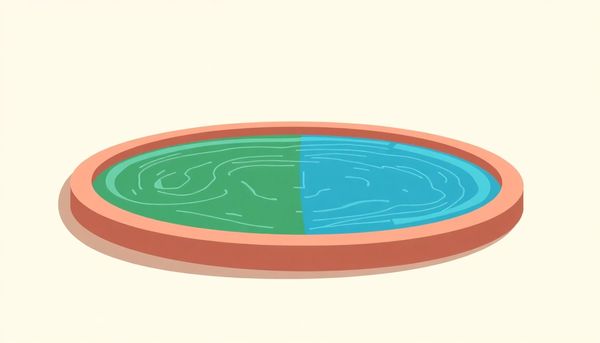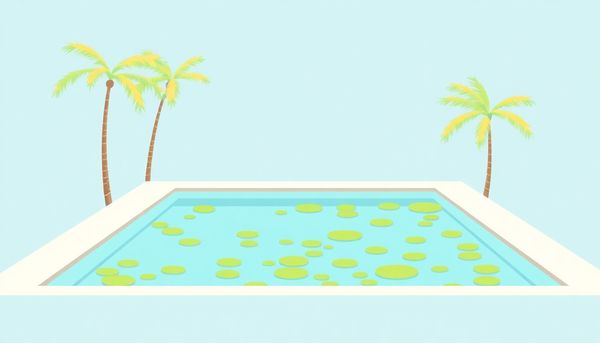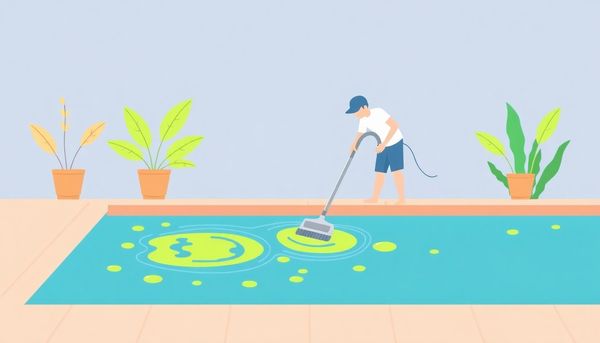How to Restore Your Green Pool to Crystal Clear: A Complete Guide
March 22th, 2024
March 22th, 2024
There’s an undeniable allure to owning a swimming pool, especially one shimmering with salt water. Yet, the magic quickly wanes when you step outside to find your pool transformed into a murky green swamp. This is a struggle many pool owners face, often baffled by how to reclaim that inviting azure blue.
Years ago, I faced the same dilemma. My once-pristine pool had turned verdant overnight, a spectacle that was more pond than paradise. After some research and trial and error, I learned the secrets to restoring my pool’s former glory. A green pool indicates an imbalance, often caused by algae, which thrives when chlorine levels fall, filtration systems falter, or when Mother Nature’s elements tip the scales.
Understanding the root cause is crucial. Algae are opportunists, waiting for any lapse in pool maintenance to take hold. This is where the battle begins. It’s not just about adding chemicals willy-nilly. It involves testing water chemistry, scrutinizing the filter's performance, and checking all equipment. The right approach is systematic and thorough, ensuring that every factor contributing to the green plague is addressed.
This guide will navigate you through each step of the restoration process, sharing techniques that transformed my own pool. With careful attention and a little patience, your backyard haven will sparkle once more, ready to welcome swimmers back into its refreshing embrace.

Algae in your pool is a bit like an uninvited guest that quickly overstays its welcome. To effectively evict this unwelcome visitor, understanding the specific type of algae you're dealing with is crucial. Each variety demands a unique approach, so let’s pull back the curtain on these sneaky culprits.
First up is the notorious green algae, or Chlorophyta, often the prime suspect when your pool turns murky. Resilient and fast-reproducing, it thrives in pools with insufficient free chlorine. If your pool water has suddenly taken on an emerald hue, you’ve likely encountered this pesky intruder.
Next, we have mustard algae, a misleading name for something that could easily be mistaken for pollen. This yellowish menace tends to settle in shady corners, where chlorine struggles to reach. Its sandy-looking clusters can quickly multiply if left untreated.
Then there’s the formidable black algae, known for its stubbornness. These dark spots, often mistaken for benign discoloration, root themselves deeply into your pool’s plaster, making them a challenge to eradicate. Their resistance to chlorine demands a formidable response.
Don’t be fooled by the harmless appearance of pink slime. Although not technically an alga, this bacteria can infest pool surfaces and equipment, turning your pool into a breeding ground for germs. Swift action is essential to avoid swimming in a microbial soup.
Armed with this knowledge, identifying and treating your pool’s algae becomes less of a guessing game and more of a strategic battle plan.
In the battle against pool invaders, algae often take the spotlight. However, not all green pool issues are algae-related, and misidentifying these culprits can lead to wasted time and resources. Algae come in various hues and textures, each requiring its own remedy, but lookalikes can complicate the diagnosis.
A common imposter is pollen. During certain seasons, the water can mimic an algae bloom, turning green with a dust-like film floating on its surface. Unlike algae, pollen doesn't attach itself to pool surfaces and can be easily skimmed away. If your pool clears up significantly after a good skimming session, your foe may not be algae after all.
Another deceiver is copper. High copper levels can turn pool water turquoise or green, especially when oxidized by chlorine. Unlike the slime of algae, copper doesn’t present with texture but a straightforward tint. A water test can confirm whether copper is the cause, allowing you to treat it with a metal sequestrant instead of an algaecide.
Phosphates are another sneaky player. While they don't color the water directly, high phosphate levels can fuel algae growth. If your pool seems to host endless algae blooms despite regular treatment, testing for phosphates might reveal the underlying issue.
Understanding these imposters helps target the real problem efficiently, saving both time and those precious crystal-clear pool days.
Battling algae in your salt water pool is much like gearing up for an unexpected challenge. It's all about having the right tools at your disposal and knowing how to wield them effectively. I once found myself staring at a pool that looked more like a witch's cauldron than a backyard oasis. The magic? Proper tools and a bit of determination.
Scrubbing the walls and floor of your pool with a sturdy algae brush can seem like a tedious task, but it’s essential. This brush helps dislodge and expose the algae to chlorine, making it easier to kill. I remember spending a whole afternoon brushing — a bit like a workout session but far more rewarding when you see the clear water return.
Next up is the pool vacuum. This isn't your everyday tidy-up. Manually vacuuming ensures that you’re removing the pesky algae debris for good, rather than allowing it to settle back into your pool. If your vacuum has a “waste” setting, use it to prevent recycling any remnants into your water. After a thorough cleaning, you might need to top off your pool with fresh water, so be prepared for that.
Don’t underestimate the power of filtration. Your pool filter is an unsung hero, trapping remaining algae spores and ensuring your water remains pristine. Running it overnight can work wonders, transforming murky waters by morning. With these tools and practices, what seemed like an insurmountable problem will soon be a mere memory, allowing you to reclaim your poolside paradise.
Algae blooms can be a persistent problem for pool owners, but a few proactive steps can keep them at bay. First, maintain consistent water chemistry. Regularly test your pool’s pH, chlorine levels, and alkalinity. Keeping these levels balanced is your first line of defense against algae. A friend of mine once let her pool's pH slip, and within days, she was battling a serious green takeover. Trust me, consistent monitoring and adjustment can save you from that hassle.
Next, invest in a quality pool cover. It seems simple, but a cover can significantly reduce debris and organic material that algae thrive on. During a vacation, I covered my pool religiously, and returned to find it as clear as when I left. This small step can prevent headaches, especially during long breaks from home.
Another effective measure is using an algaecide regularly. While some might see it as an extra expense, it’s a cost-effective measure that wards off potential blooms before they start. Consider setting a reminder to add it during your weekly maintenance routine.
Finally, ensure proper circulation. Algae love stagnant water, so keep your pool’s pump and filtration system in top condition. A neighbor of mine learned this the hard way; a malfunctioning pump led to a stubborn algae outbreak. Regular equipment checks can help avoid similar issues. With these strategies, your pool's clarity can be preserved, keeping it inviting and pristine all season long.

When you glance at your once-inviting pool and see a murky green swamp, it’s time for some decisive action. Boosting chlorine levels is your first line of defense against stubborn algae. Unlike traditional pools, salt water systems rely on a steady trickle of chlorine generated from salt. While this method is gentle on skin and hair, it might not pack enough punch during an algae invasion.
Step up your game by manually adding chlorine. Start by calculating the right amount for your pool’s size—it’s not just about dumping more chlorine in, but doing it wisely. When facing a light green algae attack, double your standard shock treatment. For darker, more resistant algae, triple the dose. Mustard and black algae require even stronger measures; be prepared to quadruple shock to send them packing.
Don’t rely solely on your generator's boost mode, as it isn’t powerful enough for significant algae issues. Instead, grab a high-quality calcium hypochlorite shock, known for its quick-dissolving, powerful action. It’s safe for salt water pools and won’t introduce unnecessary chemicals. Just remember, your pool might turn cloudy post-treatment—that’s normal. Let your filtration system run overnight to clear things up.
Once your pool regains its clarity, ensure chlorine levels drop back to safe swimming conditions. Test the water thoroughly, adjust as needed, and then jump back into your pristine oasis. By keeping a close eye on chemical levels and maintaining regular cleaning, you’ll keep algae at bay and your backyard sanctuary gleaming.
Staring into the murky depths of what was once a shimmering oasis can be disheartening, but fear not—there's a method to combat even the most stubborn pool algae. Swift, decisive action is your best ally here. The transformation from emerald waters back to crystal clarity begins with a good scrubbing. An algae brush becomes your trusty weapon against these intrusive organisms. By loosening their grip from walls and floors, you’re setting the stage for an effective chlorine assault.
Once the algae are dislodged, it's time to vacuum meticulously. Manually vacuuming ensures that no wandering spores are left to regroup. A thorough sweep to waste helps expel them from the pool entirely, clearing the path for the next step in your algae annihilation plan.
Balancing your water chemistry is crucial. Adjust pH and alkalinity to optimal levels before introducing a chlorine shock. For different algae types, the chlorine dose varies: from doubling it for light green intrusions to quadrupling for the tenacious black algae. It’s chlorine’s time to shine, obliterating algae with each potent dose.
After shocking, the pool's water might resemble a milky soup, but filtration is your savior here. Let the system run overnight, aiding in the removal of suspended particles. If clarity remains elusive, a pool water clarifier can help coalesce stubborn particles, making them easy prey for your filter.
Finally, don’t neglect your filter. A deep clean ensures no hidden spores remain to launch another attack. Consider this regime your algae-eviction notice, with measures to ensure they don’t return. Regular maintenance and vigilance are key. With these strategies, your pool will soon be a shimmering retreat once more.
Understanding the delicate dance of maintaining optimal chlorine levels in your salt water pool is crucial for keeping algae at bay. Think of it as the secret sauce to sparkling waters and carefree swims. A salt water pool, while gentler on the skin, still relies on a consistent flow of chlorine generated from your salt chlorine generator. This system turns salt into chlorine through electrolysis, ensuring a steady trickle rather than an overwhelming dose. However, a slight imbalance can tip the scales in favor of those unsightly algae blooms.
To prevent this, regular monitoring is key. Invest in reliable test strips and make it a habit to check chlorine levels frequently. Aim for a free chlorine level between 1 to 3 parts per million (ppm). This range is your sweet spot, providing enough sanitizer to keep algae at bay while remaining safe for swimmers.
Troublesome weather, like heavy rain, can dilute chlorine levels, as can a sudden influx of swimmers. In these cases, cranking up your chlorinator or adding a chlorine boost manually can help maintain balance. Remember, just like a seasoned chef tastes their food, a pool owner must regularly test and adjust their pool’s chemistry. Personal experience taught me this lesson the hard way—after a storm rolled through, I woke up to a pool resembling a murky lagoon. Since then, staying vigilant keeps my pool inviting and algae-free.
Leveraging the boost mode on your salt water chlorinator might seem like the magic wand you need to tackle an algae-infested pool. However, relying solely on this feature is akin to expecting a gentle breeze to clear away a storm. Boost mode cranks up the chlorine output by a significant margin over a short period, but it won’t pack enough punch to combat a full-blown algae issue. It's like attempting to put out a wildfire with a garden hose—effective in some situations, but not when the flames are raging.
First, consider boost mode as a supplemental tool rather than a standalone solution. After a family barbecue when everyone took a dip, or during particularly stormy weather, the boost mode can come in handy. It helps maintain optimal chlorine levels by adapting to the increased demand placed by additional swimmers or diluted chemicals. However, for algae outbreaks, you need a more aggressive approach.
Combine boost mode with manual scrubbing and vacuuming to maximize effectiveness. Scrubbing loosens algae from the walls and floor, allowing the chlorine to reach and eradicate deeper layers. Vacuuming ensures those pesky particles are removed from the water, preventing them from reattaching. Finally, follow up with a shock treatment specifically tailored for your pool’s algae type—this combination ensures a thorough cleanse. Remember, boost mode is your ally in prevention and maintenance, not a cure-all for severe cases.

When confronting a green invasion in your salt water pool, the task of scrubbing the pool surfaces becomes crucial. Algae thrive by clinging to every available nook and cranny, making your pool walls and floor their favorite hangout spots. Armed with a trusty algae brush, you'll need to embark on a vigorous cleaning mission.
Have you ever noticed how a stubborn stain on a favorite shirt requires more than a gentle wash? Similarly, algae are relentless and demand focused effort. Start by brushing the pool surfaces methodically, paying extra attention to corners and steps where algae particularly love to hide. As you scrub, you're not just cleaning; you're disrupting the protective layer algae forms, making it vulnerable to chlorine's cleaning power.
Remember those Saturday mornings when you deep-cleaned the house, and how satisfying it felt to see everything spotless? Bringing that enthusiasm to your pool will help ensure thorough cleaning. For especially tough spots, a stainless steel brush can offer added strength, but only if your pool surface can handle it. Otherwise, a sturdy nylon-bristled brush will work wonders without causing damage.
While scrubbing may not seem glamorous, it's as essential as any other step in pool maintenance. This hands-on approach, combined with chemical treatments, ensures that the algae have no place to hide, setting the stage for a return to crystal-clear waters. After tackling this task, you'll likely find yourself admiring the gleaming results, ready to enjoy a refreshing swim once more.
A salt water pool should be a haven of relaxation, not a breeding ground for unsightly algae. Recognizing the type of algae invading your pool is crucial in choosing the right treatment method. Each type has its own quirks and challenges, much like the stubborn weeds in a garden.
Green algae, the most common culprit, thrives on neglect. This fast-spreading algae turns your water into a murky mess when chlorine levels drop. A slight haze can escalate into a full-blown green takeover if not addressed promptly.
Yellow or mustard algae, on the other hand, is a sneaky visitor. Often mistaken for pollen or dirt, it lurks in the pool's shadows, clinging to walls and floors. Resistant to chlorine, this variety requires repeated and thorough treatment to eradicate.
Then there’s black algae, a formidable foe that defies its misleading name. Though not true algae, these tough spots embed themselves into pool surfaces, making them incredibly hard to remove. They demand a rigorous brushing and shock treatment to even begin fading away.
Lastly, pink slime isn’t algae at all, but a bacterial menace. A tell-tale pink film around your pool equipment signals its presence. Treat it with the same urgency as an algae bloom to keep your pool's ecosystem in balance.
So, don your detective hat and scrutinize that murky water. Identifying the algae type is the first step to evicting these unwelcome guests from your aquatic oasis.
When the walls and floor of your pool become a breeding ground for algae, it's time to roll up your sleeves and get scrubbing. Algae thrive in neglected corners and on surfaces where they can cling tightly, so a thorough cleaning is your best defense. Start by grabbing an algae brush specifically designed for your pool's surface type. Whether concrete, fiberglass, or vinyl, the right brush can make a significant difference. With firm, steady strokes, scrub every inch of the walls and floor to dislodge the algae.
You might recall from a science class that friction generates heat, and in this case, it also generates a better opportunity for your chlorine to do its job. Once the algae's protective layer is broken, the chlorine can penetrate deeper and work more effectively. This process might remind you of cleaning that stubborn shower tile grout—tedious but rewarding once you see those clean lines emerge.
After scrubbing, let your pool's filtration system join the fight. Manually vacuum the debris you've loosened, ensuring you vacuum to waste if possible. This method ensures algae do not re-enter your pool through the filtration system. You may find it's like vacuuming the living room after a grand party—a bit tiring, but necessary to restore order. Adding water afterward will help maintain the pool’s water level, much like refilling a favorite coffee mug after a satisfying sip. The result? A pool ready to bounce back to its former glory, free from the green invaders that dared to spoil your summer fun.
The sight of a green pool is enough to dash anyone’s summer plans, but fear not, there's a straightforward path to reclaiming that oasis. Start with a robust shock treatment, the pool equivalent of a wake-up call. The shock raises chlorine levels dramatically, which is crucial for wiping out algae. Choose calcium hypochlorite for its potent effect on stubborn blooms. Depending on the severity, you might double, triple, or even quadruple the usual shock dosage, ensuring every last algae spore meets its match.
After shocking, your water might resemble a cloudy potion, but that’s where filtration steps in. Run your filtration system continuously for at least eight hours. This relentless flow helps whisk away destroyed algae particles, clearing the water. If clarity is still elusive, pool water clarifiers can assist by clumping the debris together, making it easier for the filter to capture.
Beyond shock and filtration, maintaining the health of your filter is paramount. Deep cleaning or replacing your filter ensures it operates at peak performance, preventing any slip-ups in water cleanliness. Regular backwashing of sand or diatomaceous earth filters helps, but a fresh filter is a surefire way to keep algae from clawing its way back. By treating your pool like the delicate ecosystem it is, with proper shock and filtration, you set the stage for a pristine swimming experience all season long.

When you first notice algae creeping into your saltwater pool, a trusty vacuum becomes your best ally. While scrubbing the walls and floors loosens the algae, vacuuming is the essential step that ensures these nuisances are permanently removed. Start by setting your pool vacuum to "waste" mode. This directs the algae out of your pool, bypassing the filter, which prevents any chance of it sneaking back in through the return lines.
Imagine the satisfaction as you glide the vacuum head over the pool floor, watching the green clouds vanish into the abyss. It's similar to mowing a lawn, where each pass leaves a pristine path behind. In my own backyard oasis, I've always found this process oddly therapeutic. It's a methodical dance, with each sweep reclaiming the turquoise glory of your pool.
You'll want to pay extra attention to the corners and steps, those tricky areas where algae love to lurk. Don’t rush; take the time to ensure every inch is covered. Once completed, remember to replenish the water level, as vacuuming to waste will lower it significantly.
Keeping the pool's water chemistry balanced is crucial post-vacuum. After all, an imbalance is often what invited the algae in the first place. This step might feel like one of many in the pool-cleaning saga, but it's incredibly rewarding. Once you've conquered the green invader, you can bask in the triumph of a clear, shimmering pool ready to welcome swimmers once again.
Looking out at a pool gone rogue with swirling green hues might feel like a scene from a horror movie, but turning that swamp back into an oasis is very much within reach. First, gear up with that trusty algae brush. By loosening algae from the pool’s walls and floor, you’re setting the stage for chlorine to work its magic effectively. Scrub with vigor; every stroke helps dislodge these pesky invaders.
Next up, the vacuum. This step is crucial. Use a manual vacuum and make sure you're directing the waste out of the pool – not back in – to capture all that floating debris. Don’t forget to check the water level afterwards; you might need to top it up. Once you’ve cleared the pool of visible algae, it’s time for a chemical onslaught.
Reach for a calcium hypochlorite shock – your pool’s knight in shining armor. Depending on the infestation, you might need to double, triple, or even quadruple the dose. Each type of algae demands its own strategy; for instance, mustard and black algae laugh in the face of regular doses, so don’t hold back.
Finally, your filter is the unsung hero in this battle. Run it relentlessly overnight to sift out the cloudy aftermath of dead algae. If the water doesn’t clear as expected, a pool water clarifier can lend a helping hand. Reinforce this strategy with regular algaecide applications and water testing to maintain a pristine pool and keep algae at bay.
The heart of a healthy pool beats in its balanced chemistry. In the battle against algae, maintaining the right chemical equilibrium is your strongest ally. First, ensure your pH levels hover between 7.2 and 7.6. Stray too far from this sweet spot, and your chlorine won’t be able to do its job effectively. Algae love an unbalanced pool; they thrive in water that’s either too acidic or too basic.
Next up is the hero of pool sanitation—chlorine. In a salt water pool, free chlorine levels should ideally be between 1 and 3 ppm. Regularly check these levels with test strips or a liquid test kit. I once learned the hard way that ignoring this simple step can lead to a green invasion overnight. Imagine waking up to what looks like a scene from a monster movie.
Alkalinity is another key player, acting as a buffer for pH levels. Aim for a range of 80 to 120 ppm. If you notice fluctuations, a dose of baking soda can work wonders to stabilize things. Don’t forget about calcium hardness, especially if you’ve got a concrete or plaster pool. Too little and the water becomes aggressive, too much and it turns cloudy. Keep it between 200 and 400 ppm for peace of mind.
In the end, a balanced pool isn’t just about avoiding algae—it’s about creating a safe, inviting space for everyone to enjoy. Regular testing and adjusting might seem tedious, but it’s these little efforts that keep your pool sparkling clear and free from unwanted guests.
Cleaning a green saltwater pool feels like a daunting task, but with the right techniques, the transformation can be surprisingly satisfying. Begin by considering the tools at your disposal. A high-quality algae brush is indispensable. Its stiff bristles are your best ally against stubborn algae clinging to walls and the pool floor. Imagine the satisfaction of seeing the green patches fade with every stroke, revealing the bright blue beneath.
Next, it's time to engage the vacuum. Go slowly and methodically, allowing the vacuum to gather up every particle of loose algae. If your pool system allows, choose the “vacuum to waste” setting. This ensures that the algae-laden water is expelled from your pool entirely, leaving behind a crystal-clear finish. However, remember to monitor the water level as you may need to refill the pool afterward to maintain the ideal balance.
Don't underestimate the importance of regular filter maintenance. Algae spores can easily hide within a dirty filter, ready to reinfest your pool. A deep cleaning of the filter, using muriatic acid if necessary, is crucial to prevent this cycle. If your filter is past its prime, consider a replacement. A fresh filter, along with routine cleaning, will ensure your pool remains a sparkling oasis, free from the threat of lurking algae blooms.

Achieving the perfect balance in your pool's chemistry is akin to conducting an orchestra; each element plays a crucial role in maintaining harmony. When algae invades your salt water paradise, restoring this balance becomes imperative. Begin by testing the water regularly. A high-quality test kit or digital meter will reveal the levels of pH, alkalinity, and free chlorine, each a vital player in your chemical symphony.
You might find your pH straying from its ideal range of 7.4 to 7.6. A simple adjustment with pH increaser or decreaser can quickly set things right. Alkalinity, the buffer for pH, should hover between 80 and 120 ppm. Alkalinity increasers or baking soda can adjust these levels if needed.
Once your pool's core parameters are aligned, focus on chlorine. Your salt chlorinator works continuously, but when battling algae, manual intervention is key. Free chlorine levels should be raised to 1 to 3 ppm, but during an algae bloom, shocking your pool is necessary. Shock treatments dramatically increase chlorine levels temporarily, a decisive strike against unwanted guests like mustard or black algae.
Lastly, cyanuric acid (CYA), the chlorine stabilizer protecting against UV rays, requires monitoring too. Keep it between 30 to 50 ppm to ensure chlorine longevity without compromising effectiveness. By diligently balancing these elements, you'll restore your pool’s sparkling state and keep algae from making an unwelcome return.
When your pool decides to masquerade as a marsh, it's time to roll up your sleeves and tackle the algae invaders head-on. Algae thrive in neglected pool chemistry, and while salt water pools are generally more forgiving, they aren’t immune to these green, yellow, or black nuisances. Ignoring the problem won't work; action is your only ally.
Start by taking a good, hard look at your pool water. A dull green tint indicates the notorious green algae, while yellow or mustard hues suggest something a bit more stubborn. Black spots, often confused with mildew, are the toughest adversary—black algae, armed with roots that cling tenaciously to your pool's surfaces.
Once you’ve identified the enemy, it's time to gear up. Use an algae brush tailored for your pool type—whether concrete or fiberglass—to scrub away the top layers of algae, making it easier for chlorine to penetrate and obliterate the spores. Follow up with a thorough vacuuming session, choosing to vacuum to waste if possible to ensure those pesky particles don’t make a return trip to your pool.
Next, unleash the power of shock treatment. Depending on the severity of the algae attack, you might need to double, triple, or even quadruple your usual dose. Calcium hypochlorite shock is your best bet for a salt water pool, as it avoids unnecessary chemical additions.
Finally, let your filtration system run its marathon overnight to clear the cloudy aftermath. Complement this with a pool water clarifier if needed, ensuring nothing but clarity remains. With these strategies in place, your pool will transform from a swampy nightmare back into a shimmering oasis, ready for summer escapades.

This article provided insights into maintaining your pool. Start your pool care journey today!
Want to become a pool maintenance expert? Our free Pool School course covers everything you need to know about pool care. From basic maintenance to advanced troubleshooting, you'll learn how to:
Join over 10,000 pool owners who have already transformed their pool care routine. Get started with our free Pool School course today!